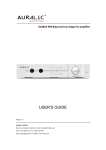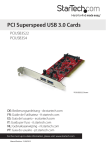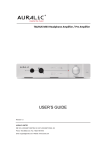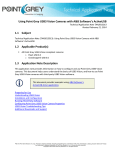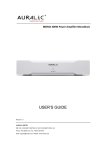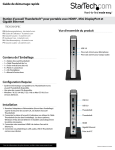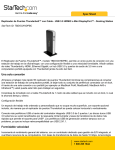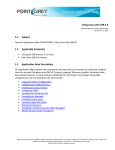Download 1.3. Application Note Description
Transcript
Transitioning from the Chameleon USB 2.0 to the Chameleon3 USB 3.0 Camera Technical Application Note TAN2015003 Revised January 29, 2015 1.1. Subject Technical Application Note (TAN2015003): Transitioning from the Chameleon USB 2.0 to the Chameleon3 USB 3.0 Camera 1.2. 1.3. Applicable Product(s) Chameleon USB 2.0 Chameleon3 USB 3.0 Application Note Description The Chameleon3 camera offers existing Chameleon users an upgrade path to enable new features and improvements enabled by the USB 3.0 interface and the Chameleon3 camera platform. The purpose of this Technical Application Note is to: Describe the improvements and benefits of Chameleon3 USB 3.0 (CM3) Compare the specifications between Chameleon3 and Chameleon USB 2.0 (CMLN) Answer some frequently-asked questions about transitioning from the Chameleon to the Chameleon3 camera. Improvements and Benefits Camera Specifications Mechanical Specifications GPIO Specifications Software and Driver Support Frequently Asked Questions About Upgrading Reference Documentation Additional Downloads and Support PGR, the Point Grey Research, Inc. logo, Blackfly, FlyCapture, Digiclops, Dragonfly, Dragonfly Express, Chameleon, Firefly, Flea, Grasshopper, Ladybug, Zebra, Scorpion and Triclops are trademarks or registered trademarks of Point Grey Research, Inc. in Canada and other countries. Copyright © 2015 Point Grey Research, Inc. All rights reserved. Point Grey TAN2015003 1.4. Transitioning from the CMLN to the CM3 Camera Improvements and Benefits The Chameleon3 USB 3.0 camera brings improvements in areas of product performance, reliability and user experience. Performance USB 2.0 employs a communication architecture where the data transaction must be initiated by the host. The host frequently polls the device to ask for data, and the device may only transmit the data once it has been requested by the host. The high polling frequency not only increases power consumption, it also increases CPU usage and transmission latency because the data can only be transmitted when the device is polled by the host. USB 3.0 improves upon this communication model and reduces transmission latency by minimizing polling, lowering CPU usage, and allowing devices to transmit data as soon as it is ready. The increase in bus bandwidth also enables color interpolation to be done on the camera, saving host resources and enabling the frame rate of ICX445 to reach 30 FPS. For more information about the benefits of USB 3.0, please refer to the whitepaper USB 3.0: Improvements over USB 2.0. In addition to the improved performance afforded by the USB 3.0 interface, a plethora of new camera features has been added to the Chameleon3, including look up table, sharpness controls and multi shot trigger. Reliability Chameleon3 uses USB 3.0 bulk transfer as the transmission mechanism. Bulk transfer supports error recovery and data retransmission. In addition, Chameleon3 is equipped with a 16 MB frame buffer. A frame buffer is critical to improve data communication and reduce image corruption. The addition of a frame buffer allows the camera to utilize the error correction built in to bulk transfer and retransmit the corrupt data packets. The Chameleon3 also comes with screw locking USB3 connectors and a positive latch GPIO connector to secure cable connections and prevent disconnects. The camera comes with a robust metal housing, improving heat dissipation. User Experience While no camera control standard exists for USB 2.0 cameras, a standard called USB3 Vision was ratified in 2013 for USB 3.0 cameras. USB3 Vision builds upon the popular GeniCam standard and defines USB 3.0 related requirements, device identification and control interfaces, data streaming mechanisms, mechanical requirements, and testing frameworks. Chameleon3 supports USB3 Vision protocol, enabling the camera to be used with any USB3 Vision software. Customers are able to choose from a wide variety of image processing libraries and tools that are available commercially and save on development cost and reduce time to market. Revised 29-Jan-15 Copyright © 2015 Point Grey Research, Inc. All rights reserved. 2 Point Grey TAN2015003 1.5. Transitioning from the CMLN to the CM3 Camera Camera Specifications CM3-U3-13S2 CMLN-13S2 Resolution 1288 x 964 1296 x 964 Frame Rate 30 FPS* 18 FPS Megapixels 1.3 MP 1.3 MP Chroma Mono/Color Mono/Color Sensor Sony ICX445, CCD, 1/3" Sony ICX445, CCD, 1/3" Global shutter Global shutter Readout Method Pixel Size Lens Mount ADC Gain Range Exposure Range Trigger Modes Partial Image Modes Image Processing Image Buffer User Sets Flash Memory Opto-isolated I/O Ports 3.75 µm 3.75 µm CS-mount CS-mount 12-bit 12-bit -11 dB to 23.991 dB 0 dB to 24 dB 0.046 ms to 31.9 seconds 0.01 ms to 10 seconds Standard, bulb, low smear, overlapped, multi-shot Standard, bulb, skip frames, overlapped Pixel binning, ROI Pixel binning, ROI Gamma, lookup table, hue, saturation, and sharpness Color/Greyscale conversion, gamma, lookup table, white balance 16 MB N/A 2 memory channels for custom camera settings 2 memory channels for custom camera settings 1 MB non-volatile memory 256 KB non-volatile memory 1 input, 1 output N/A 2 bi-directional 2 bi-directional Unsupported 1 (over non-isolated I/O) 3.3 V, 150 mA maximum 3.3 V, 150 mA maximum USB 3.0 USB 2.0 Power Requirements 5 - 24 V via GPIO or 5 V via USB 3.0 interface 4.745 to 5.25 V via Mini-B USB 2.0 interface or JST 7pin GPIO connector Power Consumption 2.5W maximum 2 W maximum 44 mm x 35 mm x 19.5 mm (case enclosed); 40 mm x 31 mm (board level) /36 grams 25.5 mm x 44 mm x 41 mm/37 grams Non-isolated I/O Serial Port Auxiliary Output Interface Dimensions/Mass Machine Vision Standard USB3 Vision v1.0 IIDC v1.31 Compliance CE, FCC, KCC, RoHS CE, FCC, KCC, RoHS Temperature Operating: 0° to 45°C Storage: -30° to 60°C Operating: 0° to 45°C Storage: -30° to 60°C Humidity Operating: 20% to 80% (no condensation) Storage: 20% to 95% (no condensation) Operating: 20% to 80% (no condensation) Storage: 20% to 95% (no condensation) Warranty 3 years 1 year *Supported under USB 2.0 using 8 bit pixel formats Revised 29-Jan-15 Copyright © 2015 Point Grey Research, Inc. All rights reserved. 3 Point Grey TAN2015003 1.6. Transitioning from the CMLN to the CM3 Camera Mechanical Specifications Chameleon3 has a side USB 3.0 connector, which reduces the overall depth of the camera when installed. For more information, please refer to Chameleon3 USB3 Dimensional Drawings and CAD Models and Chameleon Dimensional Drawings and CAD Models. Description CM3 CMLN Top/ Bottom Front Back Side Revised 29-Jan-15 Copyright © 2015 Point Grey Research, Inc. All rights reserved. 4 Point Grey TAN2015003 1.7. GPIO Specifications Camera Side Connector Cable Side Connector Number of Pins Opto-isolated I/O Ports Non-isolated I/O Serial Port 1.8. Transitioning from the CMLN to the CM3 Camera CM3 JST BM09B-NSHSS-TBT JST NSHR-09V-S 9 1 input, 1 output 2 bi-directional Unsupported CMLN JST BM07B-SRSS-TB JST SHR-07V-S-B 7 N/A 2 bi-directional 1 (over non-isolated I/O) Software and Driver Support Description Driver Options USB3 Vision Support CM3 Point Grey PGRxHCI driver Point Grey PGRUSBCAM driver Yes CMLN Point Grey PGRUSBCAM driver No For more information on using third party USB3Vision software with Chameleon3, please refer to the following application notes: Using Point Grey USB3 Vision cameras with A&B Software's ActiveUSB Using Point Grey USB3 Vision cameras with Matrox Imaging Library Using Point Grey USB3 Vision cameras with MVTec HALCON 11 Using Point Grey USB3 Vision cameras with National Instruments' Vision Acquisition software Revised 29-Jan-15 Copyright © 2015 Point Grey Research, Inc. All rights reserved. 5 Point Grey TAN2015003 1.9. Transitioning from the CMLN to the CM3 Camera Frequently Asked Questions About Upgrading What new hardware do I need to use the Chameleon3? Cable—The Chameleon3 camera requires USB 3.0 Micro-B cables. USB 3.0 cables can also be purchased directly from Point Grey. ACC-01-2300 - 3 Meter USB 3.0 Cable, Type-A to Micro-B (Locking) ACC-01-2301 - 5 Meter USB 3.0 Cable, Type-A to Micro-B (Locking) ACC-01-2302 - 5 Meter USB 3.0 Cable, Type-A to Micro-B (Locking), Extended Temp While a USB 2.0 cable can be used, it will cause the camera to run at USB 2.0 speeds (slower frame rate and less bandwidth). Interface Card—The Chameleon3 camera requires a USB 3.0 port. Point Grey strongly recommends Intel, Fresco, or Renesas host controllers. For motherboards without a USB 3.0 port, users can purchase a PCI express adapter card. These adapter cards can also be purchased from directly from Point Grey. U3-PCIE2-2P01X - USB 3.0 PCI Express 2.0 x1 Host Adapter Card, 1 Channel, 2 Port, FL1100 ACC-01-1201 - USB 3.0 PCI Express 2.0 x1 Host Adapter Card, 1 Channel, 2 Port, uPD720202 ACC-01-1202 - USB 3.0 PCI Express 2.0 x1 Host Adapter Card, 1 Channel, 4 Port, FL1100 Accessories—Tripod mounts and CS-C lens mount adapters are not included with Chameleon3. These can be purchased separately from Point Grey. ACC-01-0003 - Tripod mount ACC-01-5004 - CS to C-mount adapter For more USB 3.0 system components, please refer to the application note Recommended USB 3.0 System Components. Can I connect the Chameleon3 to a USB 2.0 port? Yes, although connecting the Chameleon3 to a USB 2.0 port reduces interface bandwidth to USB 2.0. However, the camera can still maintain 30 FPS in 8-bit pixel formats. Users are still able to take advantage of the on-camera color processing as long as the frame rate and pixel format chosen is within the bandwidth limit of USB 2.0. Users can also use the Chameleon3 with USB3Vision software over a USB 2.0 bus. Can I run the Chameleon3 with my existing FlyCapture-based application? Yes, FlyCapture version 2.7 or later is recommended to control the Chameleon3 and acquire images. What is the max cable length I can use with Chameleon3? The standard maximum cable length is 5 meters for USB 2.0 devices. The USB 3.0 standard does not specify a standard length. However, Point Grey recommends using passive cables of 5 meters or less. The increasing demand for USB 3.0 cameras has also created a market for many type of cable solutions designed to solve challenges from extending cable distance to high flex USB 3.0 cables targeted for machine vision applications. Revised 29-Jan-15 Copyright © 2015 Point Grey Research, Inc. All rights reserved. 6 Point Grey TAN2015003 Transitioning from the CMLN to the CM3 Camera For more information on extending USB 3.0 cable distance, please refer to the application note Extending the Working Distance of Point Grey USB 3.0 Cameras. How can I use the Chameleon3 with non-USB3 Vision software? The Chameleon3 can be used with other software via DirectShow, open source libraries, or software adapters. For more information, please refer to the following application notes. Using Point Grey USB3/USB2 Cameras with Cognex VisionPro Streaming Point Grey USB 3.0 Cameras on Embedded Systems Using Linux with USB 3.0 How does bandwidth management differ between USB 3.0 and USB 2.0 in multiple-camera configurations? When using multiple Chameleon3 cameras, users need to manage the bandwidth of each camera to ensure the total bandwidth does not exceed the maximum allowed by the USB 3.0 bus. To manage bandwidth, users can use the packet size control in FlyCapture2 or the DeviceLinkThroughput control in any USB3Vision software. Users are able to limit the data output of the camera and ensure it doesn’t exceed the user set limit. For more information on how to setup multiple USB 3.0 cameras, please refer to the application note USB 3.0 Multiple Camera Setup. Is the Chameleon USB 2.0 camera being discontinued? No, there are no plans to discontinue Chameleon models at this time. The new Chameleon3 models are intended to give customers an alternative and provide additional features such as higher bandwidth, frame buffer selection, USB3 Vision control and more sensor selection. Revised 29-Jan-15 Copyright © 2015 Point Grey Research, Inc. All rights reserved. 7 Point Grey TAN2015003 Transitioning from the CMLN to the CM3 Camera 1.10. Reference Documentation Other useful sources of information regarding specific features of the Applicable Product(s) include: Chameleon Getting Started Manual Chameleon3 Getting Started Manual Chameleon Technical Reference Manual Chameleon3 Technical Reference Manual 1.11. Additional Downloads and Support Point Grey Research Inc. endeavors to provide the highest level of technical support possible to our customers. Most support resources can be accessed through the Support section of our website. Creating a Customer Login Account The first step in accessing our technical support resources is to obtain a Customer Login Account. This requires a valid name and email address. To apply for a Customer Login Account go to the Downloads page. Knowledge Base Our Knowledge Base contains answers to some of the most common support questions. It is constantly updated, expanded, and refined to ensure that our customers have access to the latest information. Product Downloads Customers with a Customer Login Account can access the latest software and firmware for their cameras from our Downloads page. We encourage our customers to keep their software and firmware up-todate by downloading and installing the latest versions. Contacting Technical Support Before contacting Technical Support, have you: 1. Read the product documentation and user manual? 2. Searched the Knowledge Base? 3. Downloaded and installed the latest version of software and/or firmware? If you have done all the above and still can’t find an answer to your question, contact our Technical Support team. Revised 29-Jan-15 Copyright © 2015 Point Grey Research, Inc. All rights reserved. 8








